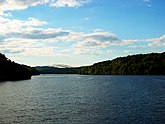geo.wikisort.org - Reservoir
The New Croton Reservoir is a reservoir in Westchester County, New York, part of the New York City water supply system lying approximately 22 miles (35 km) north of New York City. It is the collecting point for water from all reservoirs in the Croton Watershed.[1]
| New Croton Reservoir | |
|---|---|
 | |
 New Croton Reservoir | |
| Location | Westchester County, New York |
| Coordinates | 41°13′58.65″N 73°50′23.27″W |
| Type | reservoir |
| Primary inflows | Croton River |
| Primary outflows | Croton River |
| Catchment area | 57 sq mi (150 km2) |
| Basin countries | United States |
History
In 1842 the Croton River, a tributary of the Hudson River, was impounded by the Old Croton Dam to create Croton Lake.[citation needed] New York City's first source of water beyond its city limits, its waters traveled by aqueduct to the Croton Distributing Reservoir in midtown Manhattan.
In 1900, the workers (primarily Italian immigrants, Irish immigrants and African-Americans) constructing the dam went on strike to protest unfair wages. The workers were paid the standard wage for incredibly hard and dangerous work. The New York State National Guard was called in to protect replacement workers and violence ensued.[2]
In 1905 the New Croton Dam was completed, expanding the existing impoundment into the New Croton Reservoir, then the largest in the Croton Watershed, and thus one of the largest in the New York City water supply system to that point. It has a 57 square mile (148 km2) drainage basin,[3] is approximately 9 miles (14 km) long, and can hold 19 billion US gallons (72,000,000 m3) of water at full capacity.
Its waters flow into the New Croton Aqueduct, then into the Jerome Park Reservoir in The Bronx. Water from the Jerome Park Reservoir is normally distributed to parts of Manhattan, The Bronx, and western Queens[4]
Gallery
- Perspective of the reservoir
- Water treatment at the reservoir
- Plaque at the New Croton Aqueduct
- AMVETS Memorial Bridge - one of several bridges transversing the reservoir
See also
- Old Croton Aqueduct
- New Croton Aqueduct
- List of reservoirs and dams in New York
- New York City water supply system
References
- "New Croton Reservoir". dec.ny.gov. NYS Department of Environmental Conservation. Retrieved 13 March 2016.
- "The New Croton Reservoir – Public Water". Retrieved 2022-06-04.
- Staff (September 24, 1904). "Completing the Great Masonry Dam of, the New Croton Reservoir". Scientific America. Archived from the original on 17 October 2012. Retrieved 13 March 2016.
{{cite journal}}: Cite journal requires|journal=(help) - Staff. "Croton Water Supply System". ascemetsection.org. American Society of Civil Engineers. Retrieved 13 November 2016.
Другой контент может иметь иную лицензию. Перед использованием материалов сайта WikiSort.org внимательно изучите правила лицензирования конкретных элементов наполнения сайта.
WikiSort.org - проект по пересортировке и дополнению контента Википедии




